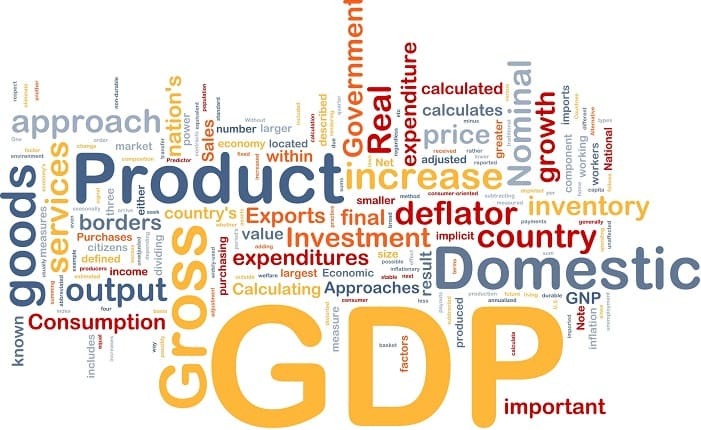
 Data Structure
Data Structure Networking
Networking RDBMS
RDBMS Operating System
Operating System Java
Java MS Excel
MS Excel iOS
iOS HTML
HTML CSS
CSS Android
Android Python
Python C Programming
C Programming C++
C++ C#
C# MongoDB
MongoDB MySQL
MySQL Javascript
Javascript PHP
PHPPhysics
Chemistry
Biology
Mathematics
English
Economics
Psychology
Social Studies
Fashion Studies
Legal Studies
- Selected Reading
- UPSC IAS Exams Notes
- Developer's Best Practices
- Questions and Answers
- Effective Resume Writing
- HR Interview Questions
- Computer Glossary
- Who is Who
What is the full form of GNP?
Introduction
Gross National Product (GNP) is the sum of all commodities and services generated over the course of a nation's economy, often a year.

Policymakers frequently assess the performance of a nation's economy using GNP, which is a crucial economic statistic.
Calculation of GNP
A country's total output of goods and services, including those produced by foreign companies with local offices, must be added up to determine its GNP. Due to the fact that GNP accounts for all sources of income, including both personal and commercial income, inside a nation, this is true.
The value of products and services generated both for domestic consumption and export is also factored into the calculation of a nation's gross national product (GNP). Since imports are not produced domestically, their value is deducted from GNP while exports' value is added.
GNP is a crucial indicator of how well a nation's economy is doing since it shows how much wealth a nation's economy can produce. It is frequently used to compare the performances of other nations, especially those that share economic structures or are at comparable developmental stages.The formula of calculating GNP is
$\mathrm{\:GNP\:=\:GDP\:+\:NR\:–\:NP}$
$\mathrm{\:GDP\:=\:Gross\:domestic\:product}$
$\mathrm{\:NR\:=\:Net\:income\:receipts}$
$\mathrm{\:NP\:=\:Net\:outflow\:to\:foreign\:assets}$
The expenditure components are added up to determine a country's GNP, which provides insight into the health of the economy as a whole. It assists decision-makers in identifying areas that require greater investment and enhancing various aspects of the nation's economy that would spur growth.
Limitation of GNP as an Economic Indicator
Consumption, investment, government spending, and net exports are the four main components of GNP. Consumer spending on products and services is referred to as consumption, whereas company expenditure on capital items like machinery, equipment, buildings, and intellectual property is referred to as investment.
Net exports are the value of a country's exports less the value of its imports. Government spending is the amount of money a country's government spends on its operations, commodities, and services.
The expenditure components are added up to determine a country's GNP, which provides insight into the economy's overall performance. It assists in identifying areas that require additional investment and enhancing various aspects of the nation's economy that would spur growth. As an economic measure, the Gross National Product (GNP) has a number of drawbacks, including −
It does not take into account the income distribution − The GNP measures the entire economic output but does not show how this output is distributed among various societal groups. Even though a nation has a high GNP, the majority of its citizens may nevertheless be living in poverty if wealth is concentrated in a small number of people.
Non-monetary transactions are not taken into account. GNP solely counts market transactions; it excludes non-monetary activities like household production, volunteer work, and environmental degradation. This may misrepresent a nation's actual economic production.
Ignores the quality of life − GNP is frequently criticised for its lopsided emphasis on economic growth at the expense of social welfare and environmental sustainability. Although economic growth is vital, it does not always result in a higher standard of living for the populace.
It ignores inequality − The degree of inequality between various socioeconomic classes is not taken into consideration by GNP. A nation's GNP could be high, but if the wealth disparity between the rich and the poor is wide, it could cause social unrest.
Difference between GNP and GDP
Column A Gross national Product (GNP) |
Column B Gross Domestic Product(GDP) |
|---|---|
The GNP measures the total value of goods and services produced by a country's population, regardless of where they live, within a given fiscal year |
GDP stands for Gross Domestic Product, or the total dollar value of goods and services generated inside a country's borders within a given fiscal year. |
It emphasises the role that locals played in fostering the growth of the economy. |
The country's economy is demonstrated via GDP. |
It places a focus on the output accomplished by citizens of various countries. |
It places a focus on domestically produced goods. |
Worldwide scale |
Locally based scale |
Excluded are the commodities and services produced by foreign nationals who reside in the nation. |
Excluded are products and services produced outside of the economy. |
It exclusively assesses national production. |
It exclusively gauges production within the country. |
Conclusion
The conclusion about the gross national product (GNP) is that it represents the overall economic output of a country's people and enterprises, regardless of where they are, and it is used as a gauge of a country's economic development and well-being. GNP is criticised, nevertheless, for failing to take social or environmental considerations into account and for having the potential to produce unsustainable business practices. The Genuine Progress Indicator (GPI) and the Gross Domestic Product (GDP) are two alternative economic well-being indicators that certain nations have adopted.
FAQs
Which part of the GNP is the biggest?
Ans − Consumption makes up over two-thirds of total demand and is by far the largest contributor to GNP. The second-largest category of purchases made by the government is goods and services (G).
How many different ways are there to calculate GNP?
Ans − Three Crucial Ways to Measure National Income
Income Approach
Method of Product/Value Added
Spending Procedure.
What uses does GNP have ?
Ans − The GNP generates vital data on manufacturing, savings, investments, employment, the output of large corporations' production, and other economic indicators.

